Art & Exhibitions
artnet Asks: Massimiliano Gioni Tackles a Century of Motherhood in Art
"The Great Mother" explores a lineage of feminist attitudes to motherhood.
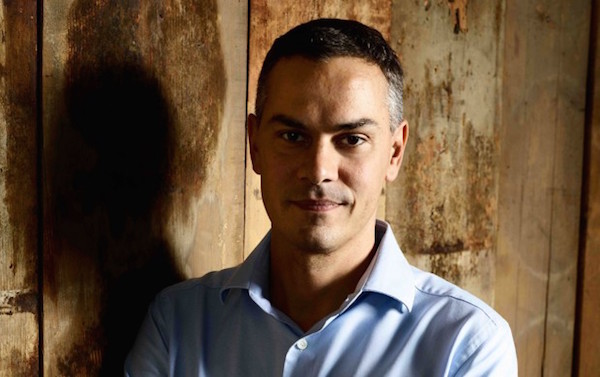
"The Great Mother" explores a lineage of feminist attitudes to motherhood.

Hili Perlson

The Fondazione Nicola Trussardi is presenting “The Great Mother,” an ambitious mega-exhibition in Milan’s Palazzo Reale, produced for the Expo in Città 2015 and curated by Massimiliano Gioni, who has been the foundation’s curator since 2002.
Opening to the public on August 26, the show will examine the complex and oftentimes contested relationship between womanhood and motherhood through its representation in the art of the 20th and 21st centuries.
artnet News spoke with Gioni about curating mega-shows, tackling the Italian stereotype of an archetypical “mamma,” and about the many doubts that arise when approaching a topic that can prove to be a minefield, especially for a male curator. The unsurprising but nonetheless bitter realization is that, throughout history and still today, women make greater personal sacrifices for their art.
Presented as part of Expo in Città, and considering its location, the exhibition is meant for a mass audience. Are you concerned that the critical approach to the topic of motherhood might be too provocative for some visitors?
I usually aim to make shows that work on different levels, both for the professionals and for those who are interested. A good exhibition has to surprise everybody, and that’s the challenge, because you need to develop more knowledge than experts on a specific topic. A show is good for the public as long as I’ve learned a lot in the process of making it.
If anything, I’m worried that the exhibition might be too brainy. You think of the great mother figure and expect to see a bunch of “madonnas” perhaps, but the connections in the show are far more complex—and that’s what’s exciting. You don’t treat your viewer like they’re stupid. They’re capable of making their own connections.
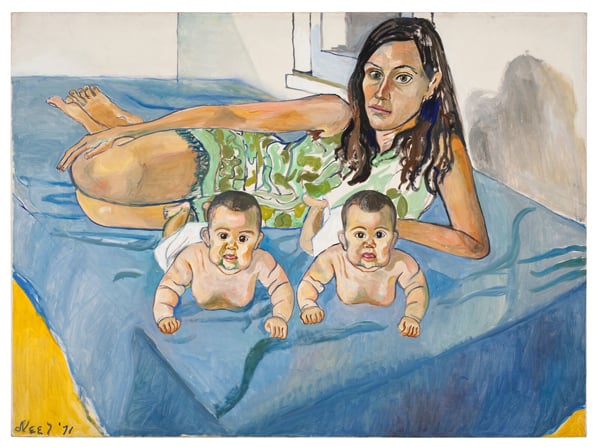
Alice Neel, Nancy and the twins (1971)
Photo:© Estate of Alice Neel
What are some of the attitudes towards motherhood presented in the show?
If you look at the history of art throughout the 20th century, artists who have engaged with the subject of maternity did so critically. I think it’s because family is another way of saying “tradition.” So this is a huge generalization, but in the first half of the 20th century artists often went against tradition, so family and motherhood became targets. Simone de Beauvoir once said that all the non-conformists attacked the mother. You could even argue that this became a form of conformity, in turn.
On the other hand, and this is another brutal simplification, but totalitarian states in particular have built an image of the mother that was more traditional because it served certain agendas of bio-politics. So, on one hand, there is that tension that runs throughout the show but what it also tries to make apparent is that, particularly in the beginnings of the avant-garde, in Futurism and Dadaism etc., there were many tremendous women artists—which is a well known fact—but we try to explain that while these movements were forward-thinking, they also proposed misogynist attitudes.
Can you elaborate on that?
The show looks at how not only were there amazing women artists in early 20th century avant-garde movements, but also, how for women being avant-garde was not just a matter of words. It’s one thing to say “I’m a revolutionary” or “I’m for free love” when you’re a man, and another thing to say and live by that when you’re a woman. What I came to understand was that many of the proclamations remained empty words when spoken by men, but real actions with powerful and oftentimes tragic consequences when they were made by women.
And going back to the question of provocation, maybe it is provocative to put a show like this in Italy, in the sense that gender studies or a certain approach common in the Anglo-Saxon world isn’t that common there, but that’s also the purpose of the exhibition.
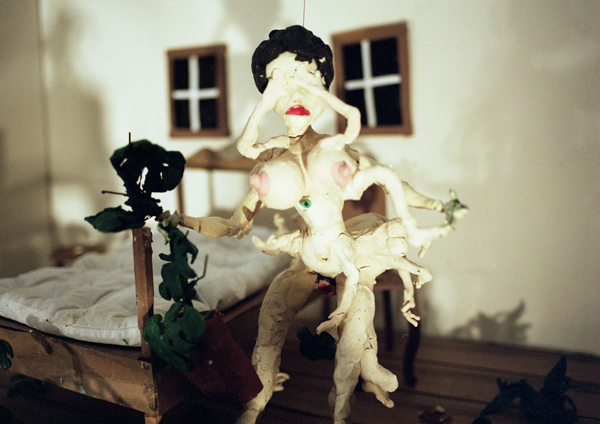
Nathalie Djurberg, It’s the Mother (2008)
Photo: Giò Marconi, Milan
The fact that women pay a higher price for their non-conformity surely didn’t look very different in the second half of the 20th century, did it?
In the 20s, Emmy Hennings, who was a Dadaist in the Zurich circles—and hers is a recurring narrative in the avant-garde—escapes her family to become an artist, and then bears a child. Same for Mina Loy, who wrote this feminist manifesto in the 1910s. One of the pieces in the show is a drawing by Meret Oppenheim depicting an exterminating angel. She made it in 1931, aged 18, and it’s a drawing of a woman literally killing a child. She did that as a kind of talisman not to become pregnant. Later on, in the 70s, she said that before the invention of the pill that’s what she needed to do. So I think when you look in the 50s and 60s, there are less dramatic expressions. Certainly, for many artists, the choice between a career and a family continued to be a problem, and it still is, but the difference between the decades is huge.
What emerges in the 60s—and I’m thinking of the work of Martha Rosler, and in a certain sense also VALIE EXPORT and Lee Lozano—is a reflection on the labor of maternity. In fact, an entire sub-movement of Feminism emerges that protests against the fact that the work of housewifes is unpaid labor, and many analyze the idea of labor in the domestic sphere as a form of exploitation. In that sense, someone like Lozano is particularly interesting because at some point she decides to stop working. She says, my work is to quit working, and sort of goes on a strike. She was not a mother and she doesn’t speak about it in feminist terms but certainly—and that’s why she’s in the show—generally stopping to work is a refusal of the idea of exploited labor that women were subjugated to.
There’s a room in the exhibition with works by Lozano, Sturtevant, and Sherrie Levine, three women who take a radical approach to the act of production. They decide to stop making new things and create from the work of others as a criticism of their rights. I saw this as parallel to the protest of feminist movements of the 60s and 70s.
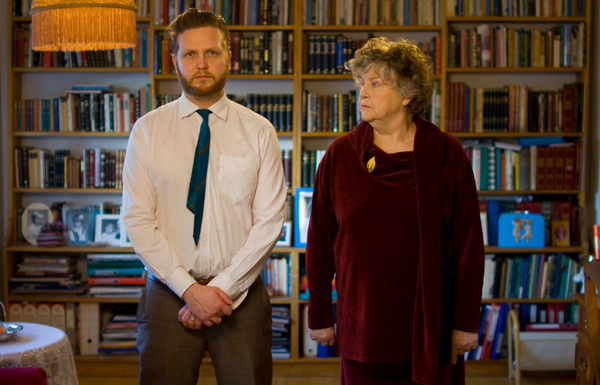
Ragnar Kjartansson, Me and My Mother (2010)
Photo: courtesy the artist, i8 Gallery, Reykjavik; Luring Augustine, New York
You decided not to make this a women-only show. Can you explain your decision?
I had two questions: Can I make this show, as a man? And should the show include male artists? One of the premise of the show comes, again, from Beauvoir, who said “One is not born a woman, one becomes one.” It’s a fantastic analysis of how the idea of womanhood is constructed. This notion that gender is a cultural construct has been further developed by queer thinkers in the 70s. If I hadn’t done the show because I’m a man, I’d confirm the idea that there is a biological grounding for thinking about gender. I also thought that one of the strongest contributions of feminists was the idea of embracing difference, and as long as you confess your partial point of view, then you can express your opinion. So hopefully, my narrative will not appear as a master narrative but as one voice.
As for including men in the show, in Italy, at the same venue, there was a famous exhibition in 1980, called “The Other Half of the Avant-Garde,” curated by Lea Vergine, which only included women. At that time, Meret Oppenheim refused to be in the show precisely for that reason. I also thought that, paradoxically, throughout the 20th century the image of motherhood was also built by men for men, so it was important to include men’s works. And I hope that when you get out of the show, gender will appear to be more of a spectrum than a binary opposition.
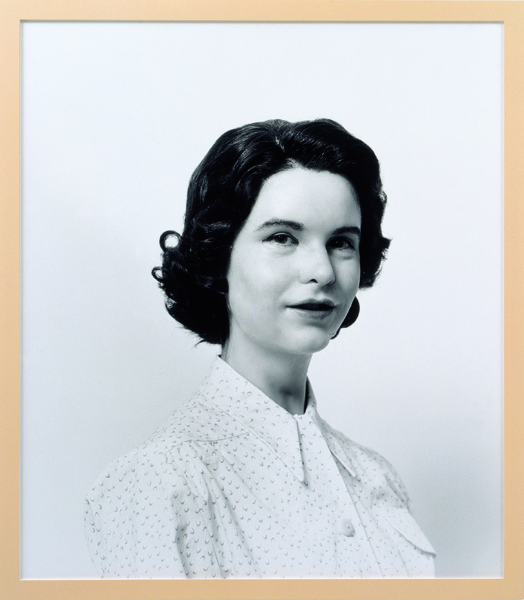
Gillian Wearing, Self Portrait as My Mother Jean Gregory (2003)
Photo: © Gillian Wearing Courtesy Maureen Paley, London
Nowadays, though, motherhood is often brought up in discussions about transgenderism, so that social progress suddenly brought the discussion back to biology.
We’ll see! (laughs). But obviously, yes. Another important source of inspiration for the show was Adrienne Rich’s “Of Woman Born.” Rich wrote this incredible book about motherhood both from her personal perspective and as an institution within the patriarchy. Her argument is that there’s no biological ground for gender, and at the same time, all the life on earth is of women born. There’s no way around that at the moment. So the show also talks about artists imagining a way out of biology, that’s why the show also becomes an exhibition about bodies and desires, and their representation, and how artists imagine different anatomies in a sense.
Rich writes this in 1976, and then reworks it in 1986. There’s been a lot of development in science in the meanwhile, and she says, it’s exciting to see the possibility of a post-biological birth, but she also—and that’s a radical position—warns that if we take women out of the equation of reproduction, that could be the end of women, because their almost magical power will be taken away. So back to your earlier question, throughout the 60s artists like Carolee Schneemann, Lynda Benglis, or Niki de Saint Phalle appropriated the mythology of the magical great mother as a form of empowerment.
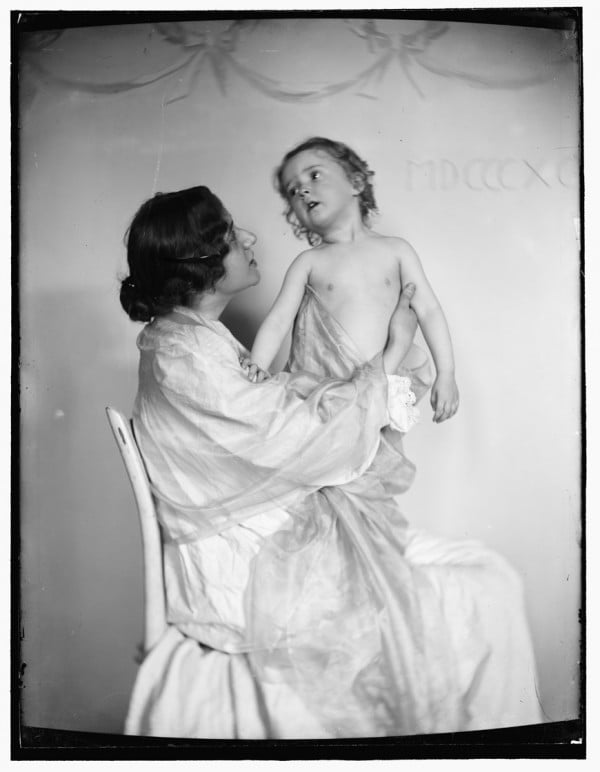
Gertrude Käsebier Adoration (1897)
Photo: The Library of Congress, Washington DC. Courtesy Trussardi Foundation
You mentioned earlier that a show is only good when you learn something in the process of making it. What did you learn from curating this show?
As I’m usually more focused on contemporary art, the most exciting thing for me was working with pieces from the 1910-1940. The Dadaist idea of the automated woman was fascinating to explore in the relationship between desire and modernity.
And the show also includes women who weren’t artists, like Olga Fröbe-Kapteyn, who wasn’t a professional so her tremendous contribution disappears from history. Or figures like Mary Wigman, because many women artists found the only point of entry through the so-called “minor” arts. An interesting concept in itself, because their contribution was extremely revolutionary as it challenged hierarchies of high and low. Many were not accepted at the table with painters and sculptors, so they worked with choreography, dance, tapestry, and artisanal arts. On the one hand, you could say they were forced there, but on the other hand, by coming in through the back door, they changed things. The idea that art is an expanded field maybe owes more to the women of the avant-grade than the men. Because at the end of the day, men were still making paintings and sculptures.
“The Great Mother” is conceived and produced by the Fondazione Nicola Trussardi in partnership with Palazzo Reale for Expo in Città 2015. On view at the Palazzo Reale in Milan, from August 26 – November 15.